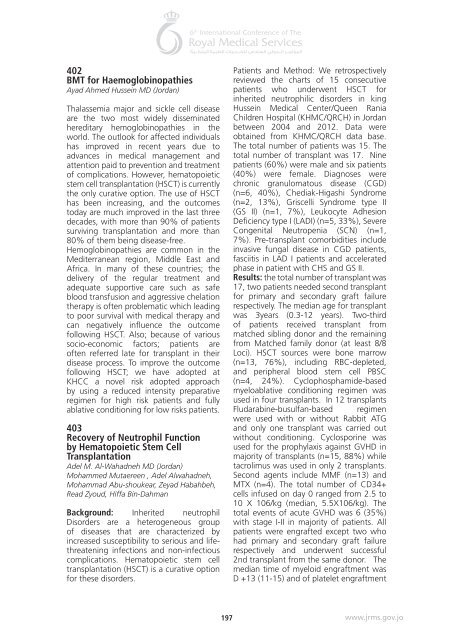Abstract book 6th RMS 16.indd
Abstract book 6th RMS 16.indd
Abstract book 6th RMS 16.indd
Create successful ePaper yourself
Turn your PDF publications into a flip-book with our unique Google optimized e-Paper software.
402<br />
BMT for Haemoglobinopathies<br />
Ayad Ahmed Hussein MD (Jordan)<br />
Thalassemia major and sickle cell disease<br />
are the two most widely disseminated<br />
hereditary hemoglobinopathies in the<br />
world. The outlook for affected individuals<br />
has improved in recent years due to<br />
advances in medical management and<br />
attention paid to prevention and treatment<br />
of complications. However, hematopoietic<br />
stem cell transplantation (HSCT) is currently<br />
the only curative option. The use of HSCT<br />
has been increasing, and the outcomes<br />
today are much improved in the last three<br />
decades, with more than 90% of patients<br />
surviving transplantation and more than<br />
80% of them being disease-free.<br />
Hemoglobinopathies are common in the<br />
Mediterranean region, Middle East and<br />
Africa. In many of these countries; the<br />
delivery of the regular treatment and<br />
adequate supportive care such as safe<br />
blood transfusion and aggressive chelation<br />
therapy is often problematic which leading<br />
to poor survival with medical therapy and<br />
can negatively influence the outcome<br />
following HSCT. Also; because of various<br />
socio-economic factors; patients are<br />
often referred late for transplant in their<br />
disease process. To improve the outcome<br />
following HSCT; we have adopted at<br />
KHCC a novel risk adopted approach<br />
by using a reduced intensity preparative<br />
regimen for high risk patients and fully<br />
ablative conditioning for low risks patients.<br />
403<br />
Recovery of Neutrophil Function<br />
by Hematopoietic Stem Cell<br />
Transplantation<br />
Adel M. Al-Wahadneh MD (Jordan)<br />
Mohammed Mutaereen , Adel Alwahadneh,<br />
Mohammad Abu-shoukear, Zeyad Habahbeh,<br />
Read Zyoud, Hiffa Bin-Dahman<br />
Background: Inherited neutrophil<br />
Disorders are a heterogeneous group<br />
of diseases that are characterized by<br />
increased susceptibility to serious and lifethreatening<br />
infections and non-infectious<br />
complications. Hematopoietic stem cell<br />
transplantation (HSCT) is a curative option<br />
for these disorders.<br />
Patients and Method: We retrospectively<br />
reviewed the charts of 15 consecutive<br />
patients who underwent HSCT for<br />
inherited neutrophilic disorders in king<br />
Hussein Medical Center/Queen Rania<br />
Children Hospital (KHMC/QRCH) in Jordan<br />
between 2004 and 2012. Data were<br />
obtained from KHMC/QRCH data base.<br />
The total number of patients was 15. The<br />
total number of transplant was 17. Nine<br />
patients (60%) were male and six patients<br />
(40%) were female. Diagnoses were<br />
chronic granulomatous disease (CGD)<br />
(n=6, 40%), Chediak-Higashi Syndrome<br />
(n=2, 13%), Griscelli Syndrome type II<br />
(GS II) (n=1, 7%), Leukocyte Adhesion<br />
Deficiency type I (LADI) (n=5, 33%), Severe<br />
Congenital Neutropenia (SCN) (n=1,<br />
7%). Pre-transplant comorbidities include<br />
invasive fungal disease in CGD patients,<br />
fasciitis in LAD I patients and accelerated<br />
phase in patient with CHS and GS II.<br />
Results: the total number of transplant was<br />
17, two patients needed second transplant<br />
for primary and secondary graft failure<br />
respectively. The median age for transplant<br />
was 3years (0.3-12 years). Two-third<br />
of patients received transplant from<br />
matched sibling donor and the remaining<br />
from Matched family donor (at least 8/8<br />
Loci). HSCT sources were bone marrow<br />
(n=13, 76%), including RBC-depleted,<br />
and peripheral blood stem cell PBSC<br />
(n=4, 24%). Cyclophosphamide-based<br />
myeloablative conditioning regimen was<br />
used in four transplants. In 12 transplants<br />
Fludarabine-busulfan-based regimen<br />
were used with or without Rabbit ATG<br />
and only one transplant was carried out<br />
without conditioning. Cyclosporine was<br />
used for the prophylaxis against GVHD in<br />
majority of transplants (n=15, 88%) while<br />
tacrolimus was used in only 2 transplants.<br />
Second agents include MMF (n=13) and<br />
MTX (n=4). The total number of CD34+<br />
cells infused on day 0 ranged from 2.5 to<br />
10 X 106/kg (median, 5.5X106/kg). The<br />
total events of acute GVHD was 6 (35%)<br />
with stage I-II in majority of patients. All<br />
patients were engrafted except two who<br />
had primary and secondary graft failure<br />
respectively and underwent successful<br />
2nd transplant from the same donor. The<br />
median time of myeloid engraftment was<br />
D +13 (11-15) and of platelet engraftment<br />
197 www.jrms.gov.jo

















